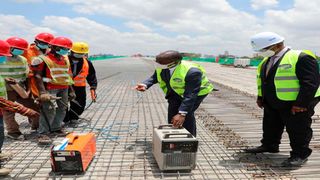
Transport CS James Macharia (bending) during the Nairobi expressway works inspection.
| Pool | Nation Media GroupNairobi
Premium
Bear with us, CS implores city residents on Mombasa Road traffic nightmare
Motorists and commuters who use Mombasa Road will have to get used to spending many hours on the road due to the ongoing construction of the Nairobi Expressway, which is set to give the city a major facelift.
For Kenya to achieve this dream, users of the road will have to endure a year of pain in traffic jams.
China Road and Bridge Corporation is working day and night to build the Sh62 billion expressway.
The expressway, which is expected to reduce travel time between Jomo Kenyatta International Airport (JKIA) and Westlands, is expected to be commissioned in April next year, according to Transport Cabinet Secretary James Macharia.
Speaking on Friday while inspecting the progress of the James Gichuru Road junction-Rironi Highway stretch, the CS said what users are experiencing is only short-time pain.
“In the meantime, I know there are a lot of inconveniences as people are spending longer hours in traffic but the reason we are constructing the Nairobi Expressway is to solve the traffic jam that was there before. If there was no traffic congestion before there would be no justification to construct the highway. This pain we are having now is very short-term pain,” he said.
The road project, which is currently at an advanced stage, will see Kenyans pay a small price for the greater good for the 27km stretch, whose construction will ensure “seamless flow of traffic”, among other economic benefits, according to the CS.
People using Mombasa Road, Uhuru Highway and Waiyaki Way are the most affected.
Create traffic snarl-ups
Motorists using both Uhuru Highway and Mombasa Road in Nairobi have been forced to use alternative routes as construction work continues to create traffic snarl-ups.
Construction work has over the past year burdened road users with long hours in traffic, with motorists having to contend with disruptions.
The ongoing construction of Nairobi Expressway on October 16, 2020.
This is especially worse during the peak hours, when motorists hurry to beat the curfew imposed on five counties, including Nairobi, as part of measures to curb the spread of Covid-19.
Despite the lost productivity and time, CS Macharia said there were losses even before the construction began and that “these are the losses we want to mitigate”.
Mombasa Road offers access to the larger Industrial Area, which houses key firms in the manufacturing and logistics business sectors.
According to the Nairobi Metropolitan Area Transport Authority, traffic gridlocks cost the capital’s economy almost Sh110 billion ($1 billion) a year in lost productivity.
Mr Macharia said the Expressway that is being built by a Chinese contractor is on track and will be completed on time.
The project is being financed and constructed by the China Road and Bridge Corporation (CRBC).
“We expect the elevated highway, which is progressing at 60 metres per day from both ends, to be completed by December and commissioned by April 2022,” he added.
The project, which links Jomo Kenyatta International Airport (JKIA) to the Nairobi-Nakuru highway, is 33 per cent done.
He said the expressway is a critical part of the northern corridor, which is the main gateway for imports and exports from the port of Mombasa to neighbouring countries such as Uganda and Rwanda.
More than 1,800 youths have been employed by the contractor. During the construction, eco-friendly measures have been taken to reduce noise and dust pollution and discharge sewage properly, according to the CRBC.
The Nairobi Expressway will consist of both a four-lane and a six-lane dual carriageway with 10 interchanges. “The new highway will also carry 85 per cent of all cargo and commuter traffic in surrounding areas,” said Macharia.
Essential infrastructure project
The government has described the expressway as an essential infrastructure project that will spur modernisation.
The partially elevated highway project was proposed about 10 years ago, but delays meant it was only launched in October 2019 by President Uhuru Kenyatta.
The Kenya National Highways Authority (Kenha) has previously clarified that CRBC, which is building the 27.1 km road, will operate the road for 27 years before handing it over to the state.
The ongoing construction of Nairobi Expressway along Mombasa road in this photo taken on April 3, 2021.
A section from Mlolongo to NextGen Mall, a distance of 18.2 kilometres, will be a flatbed road, while the section from Nextgen Mall through the City-Centre to St Marks church, covering 8.2 kilometres, will be elevated.
In January, CS Macharia said Kenyans will have to pay to use the Nairobi Expressway when it is complete after he officially gazetted it as a toll road.
“In exercise of the powers conferred by section 3 (2A) of the Public Roads Toll Act, (Cap 407), the dual carriageway with Class A standard that connects the Mlolongo with James Gichuru road along the median strip of the A8 National Road are declared to be Toll Roads with immediate effect,” read part of the notice.
The notice confirmed the toll roads begin from African Inland Church, Mlolongo and run in the central reserve to James Gichuru road.
High-capacity vehicles like transit lorries will pay between Sh500 and Sh1,550 to use the expressway depending on the distance travelled on the road, while low-capacity vehicles like saloon cars will pay between Sh100 and Sh310, according to the Kenya Gazette.
Motorbikes and three-wheelers – commonly known as Tuk Tuks – are banned on the double-decker road whose construction started early this year and will take two years to complete.
The Cabinet Secretary had previously declared three types of vehicles to be exempted from paying the prescribed tolls. These are ambulances, police and military vehicles.





